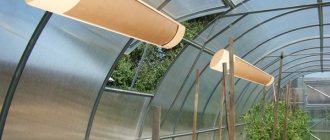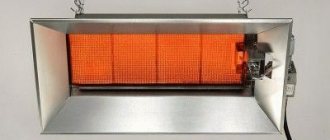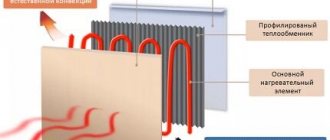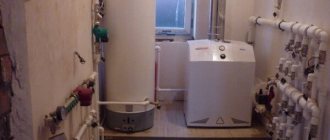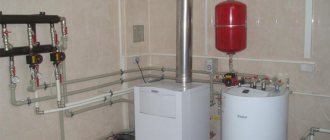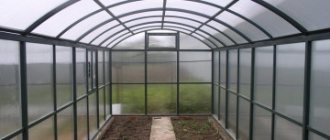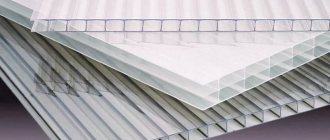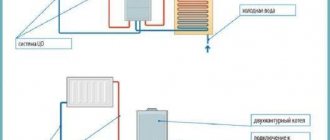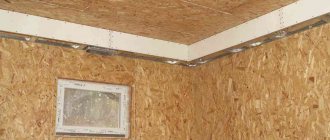The operating principle of energy-saving infrared heaters for heating greenhouses
The heating system implements 3 heating methods: radiant, convection and combined. Their heating scheme is different and very significant:
- convection – the device heats the air. Then warm air fills the room, and cold air either falls down naturally and warms up, or is forced by a fan. Objects and living beings in the room receive their share of heat from the air, and not directly from the device. There is a loss of efficiency, since the transmission chain has 3 links;
Convection infrared heater for greenhouses - radiant – the device generates infrared radiation. It does not heat the air, but transfers energy to surfaces and objects that it encounters on its way. Accordingly, the heat transfer chain is reduced by 1 link;
This is what a radiant infrared heater for greenhouses looks like - combined instrumentation combines both heating mechanisms. They are less common because they are more expensive.
This type of heater is most often installed in small rooms.
Radiant heating is more efficient: thermal radiation directly heats the plant itself and the soil, and, therefore, is both more economical and faster-acting. But the main thing is to understand how to properly arrange the inside of a greenhouse.
IR heaters for greenhouses work precisely on this principle. Regardless of the energy resource used - gas, electricity, the radiation source is a panel, plate or tube capable of generating thermal radiation.
Mount such devices as high as possible. The panel emits heat not in a straight beam, but in the form of a cone. Accordingly, the higher the apparatus is located - within reasonable limits, of course, the wider this cone is and the larger the area it covers. It is allowed to place them on the wall, but still the best location is the ceiling.
But you can read here how to grow seedlings in a polycarbonate greenhouse and what you should pay attention to.
IR heaters have many advantages:
- thermal radiation does not dry the air, so normal humidity is maintained in the greenhouse without any additional measures;
- there is no convection - forced air movement, which is undesirable in such a confined space;
- the devices operate completely silently;
- in addition, they consume less electricity or gas, since they do not expend energy on heating the air;
- The heaters are mobile, compact, and it is not difficult to arrange them in a different way when the regime requires it.
But you can watch how to grow vegetables in a polycarbonate greenhouse and how to properly organize planting in this video.
In the video, what are the types of infrared heaters for greenhouses:
The only disadvantage of the product is the need to carefully calculate the power of the device in relation to the heated area. If you make the wrong choice, however, the problem is very easy to solve: purchase a second device and place them in a different pattern.
But what are the best tomato seeds for a polycarbonate greenhouse and what should you pay attention to when planting, is described in great detail in this video.
Infrared heaters RIO
RIO infrared heaters are designed for quick and comfortable heating of any room with a ceiling height of 2.2 to 3.5 meters.
They are used as the main or additional heating system for any premises. Infrared heaters allow you to avoid irrational temperature distribution and reduce heat losses. Providing uniform heating of the room, ceiling infrared heaters do not emit odors and operate absolutely silently. The use of infrared heaters can have many advantages over other heating methods. It is known that warm air tends to accumulate under the ceiling. At the same time, the “residential zone”, i.e. the area where people live, remains cold. The higher the ceiling height, the more heat is concentrated underneath. The difference in temperature between the top and bottom points of the room can reach up to 10°C. When using conventional convective heating (central, steam or oil radiator), in order to provide 20°C in the “living area”, it is inevitably necessary to maintain 30°C above, which leads to unnecessary energy consumption. Ceiling infrared heaters RIO for everyday use.
RIO infrared heaters are designed for quick and comfortable heating of any room with a ceiling height of 2.2 to 3.5 meters. They are used as the main or additional heating system for any premises. Infrared heaters allow you to avoid irrational temperature distribution and reduce heat losses. Providing uniform heating of the room, ceiling infrared heaters do not emit odors and operate absolutely silently. The use of infrared heaters can have many advantages over other heating methods. It is known that warm air tends to accumulate under the ceiling. At the same time, the “residential zone”, i.e. the area where people live, remains cold. The higher the ceiling height, the more heat is concentrated underneath. The difference in temperature between the top and bottom points of the room can reach up to 10°C. When using conventional convective heating (central, steam or oil radiator), in order to provide 20°C in the “living area”, it is inevitably necessary to maintain 30°C above, which leads to unnecessary energy consumption. Infrared heating reduces the difference in temperature between the ceiling and the floor, the environment becomes homogeneous, resulting in no overheating of the upper zone of the room. A decrease in air temperature by 1°C leads to a 5% reduction in energy consumption for heating needs. infrared heaters are especially relevant for rooms with high ceiling heights (operating cost savings of up to 60% or more).
Infrared heating, installation of ceiling infrared heaters
Infrared ceiling heaters allow you not only to keep walls and floors free, but also to significantly expand the heating area by affecting horizontal surfaces. In this case, the maximum thermal effect is achieved, since only 10% of the energy is spent on direct heating of the air (this is pure heat loss). If the panel is not parallel to the floor, 25-30% of the energy will be spent on direct heating, therefore, thermal efficiency is reduced. Infrared heaters can be controlled by special devices - thermostats. The thermostat automatically turns off the infrared heater from the power supply when the set temperature is reached in the room, thereby reducing the energy consumption.
Heating on the balcony
In all modern new buildings, a warm, equipped loggia is commonplace. Glazing and covering of balconies is carried out during construction. Often, residents go further: they insulate, hang blinds or curtains, install heated floors, additional central heating radiators, turning the loggia into a room or office.
Balcony heating with infrared heaters
But in the case of radiators and heated floors, there are many pitfalls, which infrared heaters . A ceiling heater is cheaper than the “radiator-warm floor” duo, and you get a greater effect, because an infrared heater does not heat the air, which quickly cools down with a large balcony glazing area, but directly heats the structure of the room with heat rays, starting from the floor. You can install an infrared heater with a thermostat yourself, spending a minimum of effort and time, but only a team of qualified specialists can install a central heating radiator, and especially heated floors, which entails additional material costs and takes quite a long time. You don't have to worry about the system freezing - the infrared heater has no pipes and is not afraid of temperature changes. Dismantling the heaters is as simple as installing them, and when you move you can easily take them with you to your new apartment, and in the spring - to your dacha. Finally, infrared heaters are compact and, when suspended from the ceiling, do not take up precious balcony space. Thanks to various color options, they fit well into the interior of any room.
Heating system for a country house
Three summer months are too short for real summer residents. Fortunately, progress does not stand still, and now they can watch the leaves fall from the window of their house, warmed by heaters. Unfortunately, with the onset of cold weather, life in dacha villages comes to a standstill, but you really want to celebrate the New Year at the dacha, admiring the snow-covered garden from the window. The comfort of a country house depends on many components: high-quality design, reliable communications, interior, lighting, and so on. According to most people, the main condition for comfort in the house is warmth. In the end, if the house were warmer, the autumn harvesting work could have been completed later, and the spring preparatory work earlier. Sooner or later it becomes necessary to purchase a heating system. The electrical system is considered the safest - ideal in many respects. For those who are interested in technical innovations in the field of heating, experts offer a new heat source - infrared ceiling heaters .
Infrared heating system is an economical and environmentally friendly heating system. There is no need to attach a separate boiler room to the building or install a boiler room in the basement or basement. There is no need for time-consuming and expensive installation of a steam heating system. The thermal regime can be adjusted using thermostats in each room or centrally according to a preset program. The heaters immediately won their fans among summer residents, because today they are the most versatile and economical heating devices that will reduce heating costs by 3 times compared to any other heaters. Heaters can be used as the main or additional heating system for any premises. Even with a possible power outage, the heat in the room will be maintained for 5-6 hours. The anti-freeze function will provide a temperature of +5 degrees in the absence of the owners. This heating system is not afraid of temporary power outages; it will turn on itself without human help. The capital costs for installing such equipment are the lowest, there are no maintenance costs, and the service life of these systems is more than 25 years
Advantages of heating a polycarbonate greenhouse with IR lamps
For a summer cottage where there is a constant supply of electricity, equipping a greenhouse with infrared lamps is a fairly good heating option, because it has many positive aspects.
Economical.
With fairly low energy costs (45–60% less than with conventional heating), infrared lamps can heat large areas of beds in a greenhouse with heat losses of only 7–10%.
Productivity.
Summer residents, farmers and specialists note that using such heating in a polymer building increases the yield of vegetable crops by 30–40%, because plants and soil receive almost all the heat “sent” by IR lamps without loss.
Zoning.
If the consumer has a desire to grow in his building various varieties and varieties of plants that “love” completely different living conditions, then this will be quite simple to implement. Thanks to the ability to adjust the lamps and organize different temperature zones in the room, the summer resident will be able to simultaneously grow different types of crops.
Life time.
Such heaters have a fairly long service life - about 10 years, and there is also a warranty period that lasts from a year to 5 years - if you wish, you can “buy” from the seller additional warranty years for the purchased product.
Advice: if the consumer purchases an additional couple of years of warranty, then he must carefully read the terms of repair and replacement of the product - in order to avoid troubles, and also scan or photocopy the purchase coupon - it is often required in tandem with the warranty.
Directed action.
Many consumers have noted that when using IR lamps, the crop ripens much earlier than when using traditional heat sources. In fact, this is due to the directed effect of infrared radiation directly on the plants - they heat up, while the air remains cool and comfortable for the growth of garden crops.
Easy to install and adjust.
When organizing such a heating system, the owner will spend a fairly small amount of time, plus he will have the opportunity to either automate the heating or carry it out remotely - if he takes the switch-controller into the living room.
Practicality.
The most important advantage of such lamps is that they simultaneously illuminate and heat the greenhouse space, so there is no need to separately conduct light into the building.
You need to know: when growing sun-loving cultivated plants that need the maximum amount of light, you will still have to additionally illuminate them through the use of special lamps.
Note: when equipping a greenhouse with infrared lamps, you can simultaneously organize heating of the house with these lamps - this will save a lot of money.
Rules for heating greenhouses with infrared devices
Such equipment is very easy to install and connect, so you can handle this work yourself.
But it is necessary to follow the recommendations of specialists. For example, installing heaters near windows and doors can reduce heat loss. When organizing heating, you need to focus on the power of the devices. If devices with a power of 500 W are used, the distance from the device to the plant must be at least 1 meter. It is recommended to install such heaters in those parts of the greenhouse where the lowest temperature is observed - near the walls, windows and doors.
Kinds
When choosing an IR heater, one takes into account several criteria.
Source of released energy
Existing types of “infrared” can be:
- electrical;
- gas (halogen);
- diesel.
Heating element type
Electric heaters are equipped with the following types of heating elements.
- Ceramic - they have increased strength, heating for them is a matter of minutes, they cool down just as quickly;
- Heating elements - the advantages of tubular electric heaters are reliability and stable maintenance of the set temperature;
- Carbon - the design of such a heater is represented by vacuum tubes with carbon-hydrogen fibrous filler.
Form
In appearance, heaters can be infrared lamps of various formats, film panels or tapes. Compared to lamps, film or tapes provide the greatest energy savings and heat the soil more evenly.
Installation method
Before purchasing a “personal sun”, you should immediately decide on the placement of the device.
Depending on the mounting method, the equipment can be:
- mobile;
- stationary.
There are no questions regarding the first one - this is a portable equipment that can be moved to the desired location using wheels or special legs.
You can experiment with the installation of stationary models as much as you like, since they are available in several types:
- ceiling;
- wall;
- baseboard;
- hanging.
Suspended models differ from ceiling ones in the principle of fastening. Suspension-type heaters are built into a suspended ceiling structure, which is pre-designed for the placement of devices. To fix hanging devices, use special brackets and anchor bolts in increments of 5 to 7 cm.
The optimal place to place baseboard heaters is under a window, which helps realize their full potential by blocking the cold and drafts coming from outside.
Heating temperature
IR equipment differs in the degree of heating of the device itself.
Devices can be:
- low temperature – up to 600°C;
- medium temperature – from 600 to 1000°C;
- high temperature – more than 1000°C.
Devices with medium or high temperatures are good in spacious and high greenhouse pavilions. In these cases, warm air can be guaranteed to reach the ground, and not just circulate in the middle.
Emission range
In accordance with this parameter, IR equipment is:
- long wave;
- medium wave;
- shortwave.
According to Wien's law, there is a direct relationship between the wavelength and the temperature of the surface on which the radiation hits. Under high-temperature radiation, the wavelength increases, but at the same time they become hard and become dangerous.
Lighting devices in the form of lamps with a maximum filament temperature of 600°C are good for heating large industrial greenhouses. Long-wave equipment eliminates strong heating. It is usually used in small greenhouses on a summer cottage.
IR heaters have additional options.
- Many models of infrared equipment have a thermostat (temperature regulator) that is responsible for maintaining the set temperature.
- Any thermal heater must be equipped with a thermal switch that reacts to overloads and automatically turns off the device, preventing it from overheating.
- To ensure comprehensive safety, IR equipment is also equipped with insulators that prevent contact of the housing with the heating element.
- Particularly advanced models have a light indication that informs the user about a problem that has arisen so that he can quickly navigate and take measures to eliminate it.
- Spontaneous shutdown of floor-standing models occurs when tipped over, which simultaneously prevents damage and reduces the risk of fire to zero.
- The presence of the Antifrost system is designed to protect the heating device from the formation of ice. Even if the heater is used in harsh Russian winters, you don’t have to worry about the performance of the IR equipment.
- Many models of infrared heaters have a timer, which makes operation much more comfortable. Thanks to the ability to set the desired on and off times, you can reduce fuel costs.
Self-installation
Purchasing infrared ceiling heaters for greenhouses and choosing them correctly is not all a gardener needs to know. They also need to be installed and secured correctly. To do this, you should follow several rules:
- infrared heating of greenhouses should occur at a distance from the soil of at least one meter;
- the greater the distance from the ground, the more the heating temperature decreases and the area increases;
- the distance from the device to the plant should not be the same, so these indicators need to be changed from time to time;
- devices should be placed along the perimeter of the greenhouse closer to the walls and ceiling (ideally above the windows, if any), which will reduce heat loss;
- the number of units of equipment is calculated depending on the area of the greenhouse, maintaining the required temperature, as well as the location of the IR heaters.
Prices for such devices vary, as they depend on the manufacturer, type of design, and use of certain materials in the production.
The cost of the devices, although higher than analogues, is justified. Such an acquisition pays for itself in a short time due to saved energy and a good harvest.
The best manufacturers
The heater is chosen for more than one season. When you give your hard-earned money for an electrical appliance, you want to be sure that it will last long enough. The world's best manufacturers, whose popular models do not require additional advertising, can guarantee high quality.
Ballu
Many buyers have managed to appreciate the products of this international holding, a world leader in the production of climate control equipment. The company's product range includes more than three hundred items of household and industrial equipment:
- humidifiers and dehumidifiers; coolers and heaters;
- convection, infrared, ground, water, gas heaters;
- hand dryers;
- air conditioners, split systems, etc.
It all started at the end of the 20th century with a small company producing refrigerators and freezers BLR “Bai Lunyu Refrigerated Equipment Entertainment” in the town of Keelung near Taipei, the capital of Taiwan. Today it is a multinational corporation headquartered in Hong Kong.
MO-EL
The Italian company Moel by SALKA specializes in the production of pest control products. At the same time, climate control devices have been developed and produced: IR heaters, hand dryers, hair dryers, heating equipment, etc. The functionality of some models can be supplemented with various devices, incl. air ionizer. The popularity of the company's models is explained by the constant search for new technical solutions.
Timberk Tech
The Swedish manufacturer is a recognized leader in the production of climate control equipment. The company's products undergo rigorous quality control at each processing stage. The latest technologies are used in the production process. Buyers highly value products bearing the Timberk brand for their high quality, affordable prices and the regular appearance of new products on sale.
Electrolux
A Swedish company known throughout the world for its high-quality household appliances. All housewives know her products. These are washing machines and dishwashers, irons and steam generators, vacuum cleaners and kitchen appliances. Among all this diversity, there was a place for all kinds of heaters, convection, infrared, etc. Users note the high build quality and excellent design of Electrolux products. In 2014, the company supplied equipment to hotels in Sochi, in preparation for the Olympic Games.
Disadvantages of infrared heaters
The main disadvantage of such devices is their rather high cost compared to other types of heating equipment.
At the same time, infrared heaters are more efficient and economical (more details: “Choosing economical heaters for the home, studying the advantages and disadvantages”). You can often find complaints that these devices break down quickly. To avoid disappointment, you need to choose the right heater - good devices last for many years.
First of all, there is no need to choose cheap devices. You can often find a device from a well-known brand on the market at a lower price. In this case, you need to understand that the cost of the heater cannot be lower than what the manufacturer sells it for. A low price most likely indicates a fake - and these are the types of devices that quickly break down.
It is also necessary to buy the heater in packaging, and there should be no dents or other damage on it. It is advisable to check the functionality of the device before purchasing by asking the seller to turn it on. It is recommended not to buy a device that crackles - infrared heaters operate absolutely silently. It wouldn’t hurt to ask the seller to show a quality certificate. If it is not there, then it is better to refuse to purchase the device.
When purchasing a device, you need to receive a receipt and a warranty card with the company’s stamp.
The coupon must indicate the model, date and signature of the seller. Heating a greenhouse with an infrared heater is effective, inexpensive and safe. These devices have many advantages over other types of heating equipment. But in order not to be disappointed in the purchase, you need to buy a device from a well-known manufacturer - albeit at a higher price, but it will last a long time and will allow you to harvest a large harvest at any time of the year.
Benefits of an infrared heater
Experienced gardeners claim that infrared heaters allow them to get a truly high-quality harvest throughout the year. This type is quite economical and easy to use, it is quickly assembled and has high efficiency.
The operating principle is similar to solar heating. The device creates a natural atmosphere for plants; the temperature does not drop below +5°C, so healthy and fertile plants always grow indoors.
Advantages:
- Infrared options allow you to efficiently and evenly heat the entire greenhouse, regardless of its size. The main thing is to position the device correctly.
- This type of heating does not dry out the air, which means there is no need to worry about the health of the plants and additionally moisten the soil.
- They reduce the likelihood of fungus and infections in plants, and suppress the growth of unfavorable bacteria.
- Temperature changes that are harmful to plants are eliminated; the infrared device evenly distributes and supplies heat.
- The use of this type of heater reduces the circulation of dust throughout the greenhouse.
- Thanks to all the above factors, high plant productivity is achieved, their growth and resistance to various pests and diseases improves.
Choosing an infrared heater
To choose the right devices, you need to know what they are and how they differ. Modern IR heaters for greenhouses are produced in two types: long-wave and light. Long-wave devices are recommended for use in small spaces. They are great for heating small greenhouses. The surface of light devices heats up to 600 degrees, so they are best used for heating large rooms (for more details: “How to choose an infrared heater: a brief overview”).
It should be taken into account that infrared heaters can operate from various energy sources: liquid fuel, gas, electricity. Therefore, you can choose a device based on this parameter - for example, not all dachas have electricity, so you can buy a device that runs on liquid fuel.
Which one to choose for a polycarbonate greenhouse?
The choice of device is determined by many factors. Every single thing needs to be taken into account. The main parameters are:
- greenhouse area - if the area is more than 20 sq.m, it is preferable to choose a stationary model. In smaller greenhouses, mobile is sufficient;
- power - calculated based on the cubic capacity of the room. In fact, the calculation should be more accurate and take into account the height of the ceiling, the presence of hard-to-reach places and the possibility of installation at a particular height;
- Efficiency – the efficiency of a heater means its economy. The efficiency of electric ones is higher, but the operation of gas ones costs noticeably less;
- type of radiation - for a small room area, long-wave radiation is sufficient. For larger ones, an IR light heater will be required;
- safety – electric devices are much safer;
- installation - electric ones are easier to install; in fact, they only need to be fixed in the required place. Gas systems require the construction of air vents, since combustion products must be removed. Gas IR heaters running on liquefied gas are more mobile.
But how to organize heating for a polycarbonate greenhouse and which heating is the most efficient can be seen here.
The video shows how to choose an infrared heater for greenhouses:
Gas-powered devices are more profitable: the cost of a gas cylinder averages 3–3.5 thousand rubles. As a rule, 50 liters is enough to operate 1 device for several months. The consumption of electric models is more difficult to calculate. But in general, the operation of one IR heater increases energy consumption by 5–7%.
All gardeners will be interested in learning more about how greens are grown in a greenhouse for sale.
Can IR heaters be used in a greenhouse?
Gas or electric heating for greenhouses is considered an ideal solution to the heating issue. When choosing a heating system, the greenhouse owner needs to remember the need to create the following conditions:
- maximum uniform heat distribution;
- absence of drafts;
- efficiency;
- practicality.
Another requirement for infrared heating is safety of use and an automated heating process in accordance with external factors.
Maximum even heat distribution
The method of operation of the heater lies in the ability of infrared rays to influence the surface of objects. The range of heating power is almost not affected by the distance from the source of study, air exchange and the presence of heat loss. If you correctly calculate the power and distribute the emitters, you can get even heating of the earth and accelerated plant growth.
No drafts
One of the main reasons for the appearance of drafts is considered to be an incorrectly designed heating system. When heating large areas, forced air circulation is often created. Warm air flows rise upward, and cold air flows fall down. It is extremely difficult to obtain areas with low thermal insulation in a greenhouse. Windows and doors allow cold air to pass through, resulting in drafts to which flora are sensitive.
Infrared heating of a polycarbonate greenhouse allows you to solve this problem if you install the emitters in front of the door or window. Thus, a thermal barrier is created and heat loss is compensated, preventing the occurrence of drafts.
We recommend: Advantages of heating a garage with an infrared heater
Cost-effective, convenient and safe
Heating greenhouses made of polycarbonate or glass with radiators does not require large expenses. Installation can be done by yourself. If you use a thermostat, you will reduce your electricity or gas costs by 40%. Today, heating a greenhouse with an infrared heater is considered one of the most rationally beneficial solutions. The devices have several levels of protection. Electric heaters have a waterproof housing, which completely eliminates electric shock.
Fluorescent lamps for plants in a greenhouse: main characteristics
Fluorescent lamps are used quite often to illuminate greenhouses. Previously, these lamps were considered the best option for installation in greenhouse structures.
When choosing lamps, you need to take into account the spectrum of light - cold or warm white light, and their combination.
Cool white light is considered universal; it is used mainly for background lighting. Warm white light contains red rays and is used in greenhouses and greenhouses. Plants under a combined spectrum fluorescent lamp receive an equal amount of red and yellow rays, which have a beneficial effect on the growth of seedlings.
They have a number of advantages:
- Low price;
- Long service life;
- Do not heat up;
- Bright light;
- They practically do not emit ultraviolet and infrared rays;
- You can install the lamp yourself.
The disadvantages include the low light output and large size of the lamps, which during installation can block natural sunlight. Lamps are mounted at a distance of no more than 0.5 meters from the plants. For plants that love light, the optimal height is up to 15 cm.
Benefit from IR Emitters
Emitters of this type have their pros and cons. Electrical devices are characterized by ease of operation and practicality of use, as well as the possibility of automating the process. There are also disadvantages. Electricity is considered one of the most expensive power sources today. However, electric models require a constant connection to the network.
This process can be slightly optimized by installing them correctly in the greenhouse. To do this, you need to consider several things:
- Performance.
- Dispersion range.
The performance of electric heaters will depend on the price of electricity used per hour.
When it comes to gas heaters, practice shows high performance and economical use. But both gas and electric appliances do not dry out the air, which has a good effect on plant growth.
IR heater uses a larger heating range
Infrared radiation has long been used for industrial purposes and is considered the most effective way to heat plants in winter. But they also began to be often installed for domestic purposes.
Infrared lamps for heating greenhouses
Infrared heaters are often used to heat winter greenhouses, but farmers are often embarrassed by the high price. Recently, there has been a trend of increasing demand for infrared lamps for heating small greenhouse structures or in greenhouses where heating is problematic. IR thermal lamps emit low power, which is enough to heat a small room.
Infrared lamps have the same radiation as the sun, but without ultraviolet radiation.
The power of the IR lamp is small, so when installing in a greenhouse, you need to take this fact into account and place them at a distance of 150 cm from each other. The lamps heat up quite quickly and heat the room well. They are very small and light, so they can be placed compactly in the greenhouse without disturbing the overall appearance of the structure.
Advantages of infrared heating lamps:
- During operation, IR lamps heat the soil and the plants themselves, they give off some of the heat to the air around them - everything in the greenhouse warms up evenly;
- IR lamps and heaters can be connected to thermostats, which will signal when the air temperature drops below the optimum;
- IR heating systems consume 50-60% less electricity than electric heating;
- Fast air heating;
- Cures from IR lamps do not harm humans or plants;
- IR heating lamps do not dry out the air, so the greenhouse does not need additional humidification;
- Lamps can be installed locally for each plant type.
Infrared bulbs are screwed into a socket, and it is desirable that it be ceramic. The high temperature will cause the plastic cartridge to melt. When working, do not touch the IR lamp - you may get burned.
Advantages and disadvantages
Infrared heaters are so relevant today that they are replacing traditional radiators in modern cottages. This means that they are quite suitable for people. What benefits do these devices bring to plants? Let's look at the advantages of their work.
- Thanks to the fundamental feature of IR devices (heat does not go to the air, but directly to the soil), thermal energy is distributed throughout the greenhouse in the most optimal way.
- There is no movement of air mass that is familiar to us from bottom to top. This means that there is no circulation of dust and microorganisms. There are no drafts.
- The heat is soft, not intense, the air does not dry out, which means the microclimate in the greenhouse is preserved.
- IR devices can be installed as convenient. On walls, on racks or special mounts, as well as on the ceiling. Experts say that the best option is ceiling mounting.
- They do not make any sounds during operation.
- They have temperature sensors. This means, for example, more heat-loving exotic plants can grow in one corner, and cool-loving crops in another. The temperature can be set initially, and it will be maintained without your participation. You can also regulate the heat supply during the growth of one crop.
- The intensity and uniformity of heating can be adjusted by raising or lowering the device slightly. First you need to install the IR heater a meter from the floor, and then, as the seedlings grow, mount it higher.
- IR equipment is also growing and developing. On a more modern one, instead of a flat screen, there is a spherical one. The light rays are scattered at an angle of 120 degrees and the plants receive even more even heat.
- The room heats up quickly and cools down slowly due to the fact that heat accumulates in the soil.
- Energy consumption is more economical than with other heating options. If we talk about electricity, it saves 30–70%.
- The insulation design has no moving parts or air filters; they do not need to be replaced. This means they are durable. They can work around the clock.
- The devices are compact and easy to transport.
- Heaters are fireproof.
- You can install it yourself; you don’t need specialists for this.
IR heater in a greenhouse And now the cons:
- If the use is economical, then the acquisition is quite expensive.
- A lot of fakes of famous brands at a lower price. They don't work for a long time.
- You need to correctly calculate how much and what kind of insulation you need to buy for your premises.
LED lamps for greenhouses: what are their advantages
Lighting is very important for plant growth and fruitfulness. Therefore, when choosing and calculating the amount of lighting, you need to not be lazy and pay serious attention to this issue.
Most experts believe that the best option would be to install LED phytolamps.
Phytolamps, in addition to stimulating the growth of seedlings, do not require much energy consumption. In such lamps special phytodiodes are installed, which have only useful spectra of light radiation. The combination of red, blue, green and white light that an LED lamp emits stimulates the growth of any type of plant. The light output of an LED lamp is less than, for example, that of a gas-discharge lamp, but this does not matter in this case. This is due to the fact that the amount of light consumed, useful for plants, is higher for LED than for any other.
Another fact that cannot be overlooked is that LED lamps have a very long service life without loss of performance. On average, a lamp is used no more than 16 hours a day, and its service life is 50,000 hours. Provided that the lamp is used in compliance with operating conditions.
Among other things, energy-saving LED lamps do not emit heat, which means that they can be placed in close proximity to plants and not be afraid of sensitive leaves getting burned. The recommended distance is 25-35 centimeters. The only drawback of these lamps is their high price. However, taking into account the fact that the life of the lamps reaches 11 years, investing in LED lamps is completely justified.
What are the benefits of infrared heaters?
Infrared heaters create conditions most similar to natural heating from solar energy.
They create an optimal thermal regime in places where plants grow. The most important difference from other types of heaters is that IR devices do not generate flows of warm air, which, as a result of convection (physics cannot be fooled), rise to the ceiling, leaving the soil and plants in the cold. An infrared heater does not heat the air; it creates heat in the plant itself and the surrounding soil. Infrared heaters have a high efficiency. This means that with minimal energy costs, they are able to effectively warm up greenhouse plants and the space surrounding them.
Infrared heaters are mobile. They can be installed in any convenient place. IR heaters suppress the reproduction and development of pathogens and have a beneficial effect on plant growth, increasing productivity. Infrared heaters are easy to use. Their reliability and long service life will please the summer resident for decades.
How to calculate: lamps for greenhouses
In order to correctly calculate how much light is needed in a greenhouse, it is necessary to take into account some parameters.
Need to consider:
- Area of the illuminated area;
- The height at which the lamp is located;
- Type of lamp and its power;
- Type of plant;
- Seasonality.
According to agronomic standards, the lighting level should be no lower than 7 kLx (kilolux) and no higher than 20.
Based on these indicators, you can use an online calculator to calculate the number of lamps.
For additional energy saving and economical use of light rays, reflectors can be used. These are reflectors used to better concentrate light and minimize its scattering. It should be taken into account that if the lamp is not gas or LED, the concentration of light can burn the plants.
